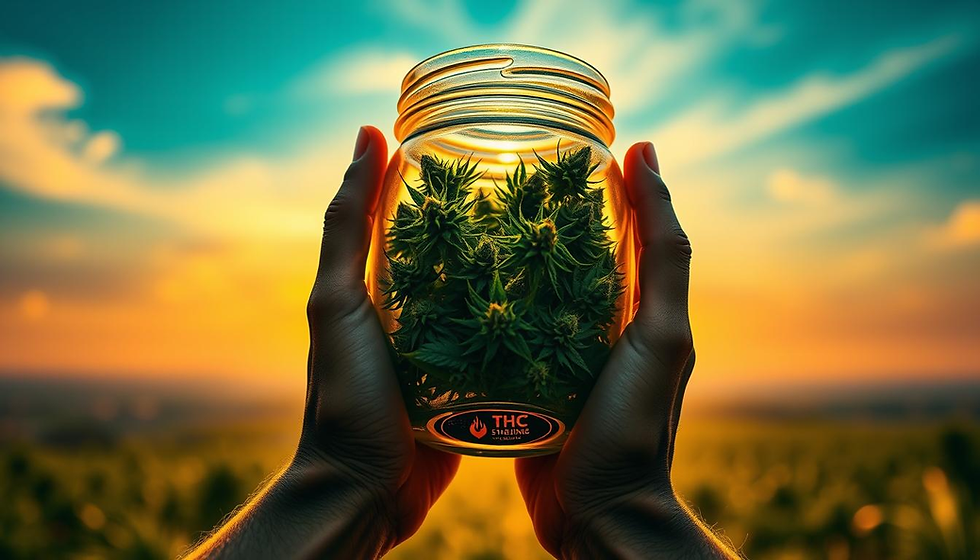Hemp Farming in India: A Sustainable Solution
- THC INDIA STORE

- Apr 6, 2024
- 4 min read
As the world becomes more conscious of the impact of human activities on the environment, sustainable farming practices are gaining popularity. One such practice is hemp farming in India. Hemp, a variety of the Cannabis sativa plant, has been used for centuries to make textiles, paper, and even food.
However, it is only recently that hemp farming has gained attention as a sustainable solution for the future. In this article, we will explore the benefits of hemp farming, how it can contribute to a sustainable future, and address some common questions about hemp farming.
Table of Contents
What is Hemp Farming?
Benefits of Hemp Farming
Hemp Farming and Sustainability
FAQ about Hemp Farming
Conclusion
References
What is Hemp Farming?
Hemp farming involves the cultivation of the Cannabis sativa plant for industrial purposes, such as the production of textiles, paper, biodegradable plastics, and building materials. Unlike marijuana, another variety of the Cannabis sativa plant, hemp contains less than 0.3% of tetrahydrocannabinol (THC), the psychoactive compound that produces the “high” associated with marijuana use.
Benefits of Hemp Farming in India
Hemp farming is an environmentally friendly and sustainable crop that offers numerous benefits. Hemp is a versatile crop that can be grown for seed, fiber, or oil, and can be used to produce a wide range of products, from clothing to car parts. It is a low-input crop that requires fewer pesticides and herbicides than traditional crops like cotton. Additionally, hemp has a shorter growing cycle, which means it can be harvested more frequently than other crops. This results in less water usage, which is a critical consideration in areas with water scarcity.
One of the most significant benefits of hemp farming is its potential to contribute to a more sustainable future. Hemp is biodegradable and can be used to make eco-friendly products that are better for the environment. It can help to maximize the use of land and may also contribute to increasing the incomes of farmers and rural communities. In addition, hemp cultivation helps to replenish the soil by removing heavy metals and other contaminants, and it’s also beneficial when included in crop rotation.
Sales of hemp products are growing quickly, especially in the United States. Hemp products account for a small percentage of food, textiles, personal care products, pharmaceuticals, and nutraceuticals sales in the U.S. and worldwide, but it is projected to have significant growth in the future. Hemp cultivation can also help reduce the carbon footprint of many industries, including the paper and textile industries, which are among the largest polluters.
To learn more about the uses of hemp, you can refer to this article. It discusses the ten best uses of hemp, including its use in construction, paper, and textiles.
References:
Hemp Farming and Sustainability in India
Hemp farming in India has the potential to contribute to a more sustainable future in several ways. Hemp can help reduce our reliance on non-renewable resources like petroleum-based plastics by producing biodegradable plastics that are better for the environment [1, 2, 3].
Hemp can also help reduce deforestation by providing an alternative source of fiber for paper and wood products [4]. Hemp can help mitigate climate change by sequestering carbon in the soil and reducing the need for synthetic fertilizers [5, 4].
Hemp is a viable alternative cash crop for farmers due to its sustainability potential [5]. Hemp farming is a sustainable and environmentally friendly alternative to many traditional crops, and it has the potential to make a significant impact on the health of our planet [5, 3]. Learn more about the sustainability of industrial hemp through this article [5].
References:
[1] Hemp Foundation. (2022). Hemp bioplastics – current market, and future.
[2] Trvst. (2019). Can Hemp Replace Oil-based Plastics?
[3] Forbes. (2019). Industrial Hemp Is The Answer To Petrochemical Dependency.
[4] NCBI. (2020). Hemp as a potential raw material toward a sustainable world.
[5] MDPI. (2021). The Sustainability of Industrial Hemp: A Literature Review.
FAQ about Hemp Farming in India
Is hemp farming legal in India?
Hemp farming is legal in many countries, including the United States, as long as the hemp contains less than 0.3% THC.
Is hemp farming profitable in India?
Hemp farming in India can be profitable, but like any agricultural enterprise, it carries risks. Factors such as weather, market demand, and crop quality can all affect profitability.
How is hemp harvested in India?
Hemp can be harvested by hand or using a combine harvester. The crop is typically cut at the base of the stalk and allowed to dry before being processed.
What are the challenges of hemp farming in India?
One of the biggest challenges of hemp farming is the lack of infrastructure for processing the crop into finished products. This can limit the market for hemp and make it more difficult for farmers to sell their crops.
Conclusion
Hemp farming is a sustainable solution for the future that offers numerous benefits, including versatility, soil health, and economic opportunities. By reducing our reliance on non-renewable resources, mitigating climate change, and promoting sustainable farming practices, hemp farming can help create a more sustainable future for all.
Consider supporting sustainable farming practices like hemp farming by purchasing products made from hemp. This can help create demand for the crop and support local farmers.








Comments